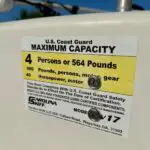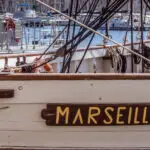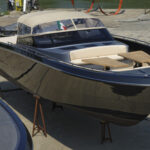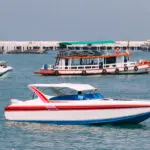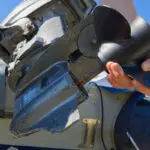Carolina Skiffs are known for their durable, quality builds. However, purchasing a used boat goes further than brand names and reputation.
If you are thinking of buying a used Carolina Skiff, you’ll need to examine the boat and ask the correct questions to prevent purchasing someone else’s headaches.
I bought a used 2014 Carolina Skiff JV17 a few years ago, and it’s a fantastic boat. In this article, ill share with you what I looked for, and what questions I asked to be sure I was getting a good deal.
Table of Contents
- What To Look For When Purchasing A Used Carolina Skiff
- Does Carolina Skiff Make Good Boats?
- Final Thoughts
- Related Posts
What To Look For When Purchasing A Used Carolina Skiff
Purchasing a used Carolina Skiff is a viable option if your budget does not allow for a new boat. Before purchasing a used Carolina Skiff, inspect it for breakages, holes, repairs, rust damage, and waterlogging.
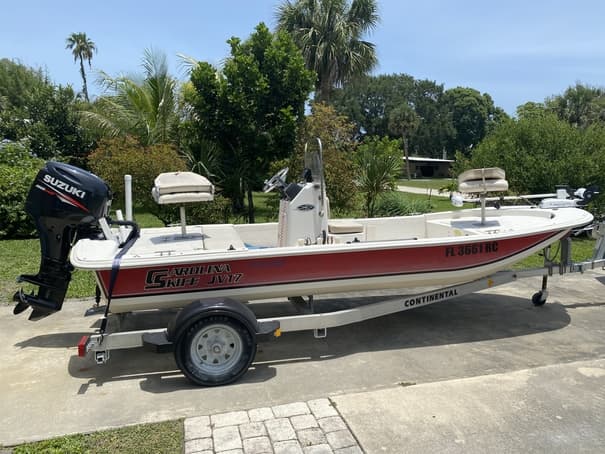
If purchasing a new Carolina Skiff is against your budget, you might consider a used one.
They are usually considerably cheaper (if you take the time to shop around), and you can find a near-mint condition boat if you’re fortunate.
However, critical to your purchase is ensuring that you are not being ripped off. Some dishonest individuals will try and push a subpar vessel onto you.
Related: Why Are Carolina Skiffs So Expensive? Here’s Why!
You can prevent a lot of future issues by:
- Working through a reputable dealer.
- Like a vehicle’s mileage, a boat’s outboard motors have a finite lifespan. Check the total number of hours the boat (and motor) worked.
- Look out for waterlogging.
- Look for cracks (spider cracks, too) and holes.
- Get an accurate boat history, do a physical inspection, and do a test run if possible.
Check For Soft Spots, Salt Corrosion, And Signs Of Abuse
The most significant action you can take to ensure you purchase a good boat is conducting a physical examination of the boat in person. Systematically examine the boat thoroughly.
Check The Transom
- Starting at the back, knock on the fiberglass and ensure it is solid. Look for evidence of spider cracks as they may indicate that something hard banged the area.
Check The Outboard Motor
- When examining the motor, do a compression check, look for fluids leaking out and check their levels. Also, look for any damages.
- Try to spin the prop in neutral, and look if it spins freely or wobbles (if it wobbles, it might have a bent shaft). Remove the access bolt and check the gear lube for shavings.

- Check the serial numbers to verify the engine’s age and parts.
- Check the skeg and prop for signs of excessive wear, damage, rust etc.
Check The Hull
- Examine the fiberglass for damages. Look for soft spots, cracks, holes, and drainage issues (trapped water). Check if there is any salt corrosion on the hull and deck from poor maintenance.
- Examine and note the hull identification number.
- Look for hull blisters and delamination.
Check The Bow Region
- Examine each locker and ensure that they are clean. What type of dirt (grease, mud, etc.) if the lockers are dirty? The cleanliness will give you an idea of if the boat is well looked after.
Check The Deck
- Open up the hatches and compartments, and look inside. Check the hinges for sticking/rust.
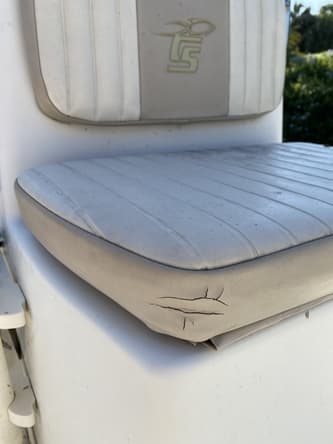
- Examine the seats (depending on the model). Can you remove them? Are there cushions or not? What condition are they in? Can you clean them?
- Check all the compartments and storage onboard (including the hinges). Are they clean? Are there exposed wires or holes?
- What does the fuel tank compartment look like? Open the access ports and see if the area is clean if there are leaks, etc.
- Check the battery. Is it working and in good condition? Does it need replacing? How old is the battery? Is there corrosion building up?
- Make sure the fuel water separators are present, working, and clean.
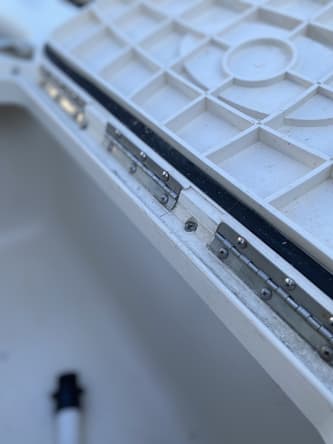
- It’s wise to check all plaques, serial numbers, and identification numbers on the boat.
Check The Center Console
- Does the stereo system work?
- Check the gauges for damages, missing dials, etc.
Check The Extras
- Was there a trolling motor mounted on it? How was the mounting done? Are there plugs for it, and are they accessible?
- Do the bow lights work?
- Is the depth finder and fish finder there? Do they work, and any damages?
Check For Rust And Salt Damage
- Examine all metal parts of the boat, particularly screws, nuts, and bolts, to see if there is rust.
- Look inside hatches, check for signs of salt corrosion, and wire chafing.
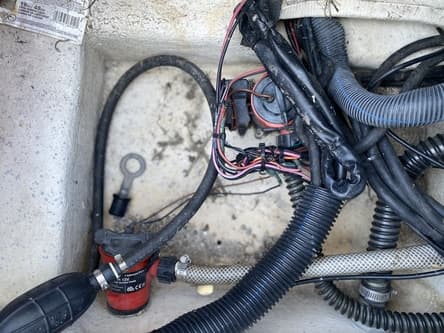
- Does it smell like gasoline? Oil? You should not smell any foul odors.
Check For Waterlogging
- An easy way to check for waterlogging on smaller Carolina Skiffs is to remove the outboard motor and as many extras as possible. Then try to lift the transom.
- Lighter skiffs should be easy to lift; the boat might be waterlogged if they feel heavier. Listen for sloshing.
- Alternatively, take the boat to be weighed and see if it is more or less on track.
Look For Modifications, Repairs, And Aftermarket Extras
- Examine the Carolina Skiff for drilled holes, extra items mounted into the deck, and any silicone or new paint jobs. These might expose the boat to waterlogging in the future.
Take The Carolina Skiff For A Test Drive
- The best diagnostic tool is if you can take the boat out on the water for a “test drive.” Look that the motor sprays and cools off.
- Check the pumps of the baitwell. Do they drain the well properly?
- Do the gauges correctly work when you’re out on the water?
Ask About Previous Ownership, History, Modifications, And Repairs
Aside from conducting an in-person physical inspection of the Carolina Skiff in question, it would be best to ask the retailer poignant questions about the boat’s history.
The most critical questions to ask include:
- Where and when was the boat bought?
- Where did the previous owner use it, and what for?
- Why did they sell it?
- How many owners has the boat had?
- What were the factory standard accessories?
- Was the boat in any major accidents?
- Were there any major repairs?
- How many hours does the engine have?
- Where and how was the boat stored?
- How much warranty is remaining?
- Enquire about service records.
Does Carolina Skiff Make Good Boats?
Carolina Skiffs are durable, stable, quality-built small vessels, and the company (Carolina Skiff LLC) is one of the leading fiberglass hull boat manufacturers in the US.
With over 30 years of expertise in the game, Carolina Skiff provides all-purpose vessels at competitive prices.
Carolina Skiffs are good solid boats and popular amongst boating enthusiasts and anglers alike.
Aside from purchasing these relatively cheap (when compared to the competition) vessels, new; there is a large used market for Carolina Skiffs.
According to BoatTrader, the most popular second-hand Carolina Skiffs models are:
- 198 DLV (discontinued)
- 19 LS
- 21 LS
- 21 Ultra Elite
- 23 Ultra Elite
Carolina Skiff Model Types And Sizes
The table below examines the various Carolina Skiff models currently available/ in production.
| Skiff Model | Length | Beam | Weight | Motor Max HP |
| 162 JLS | 16ft 2in. | 79in. | 1372lbs. | 90HP |
| 178 JLS | 17ft 8in. | 79in. | 1400lbs. | 115HP |
| 192 JLS | 19ft 2in. | 79in. | 1716lbs. | 140HP |
| 17 LS | 17ft 6in. | 96in. | 1700lbs. | 115HP |
| 19 LS | 19ft 2in | 96in. | 1900lbs. | 140HP |
| 21 LS | 21ft 1in. | 96in. | 2100lbs. | 175HP |
| 21 LS Sport & Fish DC | 21ft 1in. | 96in. | 2255lbs. | 175HP |
| 23 LS | 23ft 2in. | 96in. | 2550lbs. | 200HP |
| 25 LS | 25ft. | 96in. | 2700lbs. | 250HP |
| 19 SWS | 19ft 3in. | 91in. | 2192lbs. | 140HP |
| 21 SWS | 21ft 2in. | 91in. | 2351lbs. | 150HP |
| 19 ULTRA ELITE | 18ft 11in. | 96in. | 2266lbs. | 150HP |
| 21 ULTRA ELITE | 20ft 9in. | 96in. | 2636lbs. | 200HP |
| 23 ULTRA ELITE | 22ft 11in. | 98in. | 3000lbs. | 250HP |
| 24 ULTRA ELITE | 23ft 11in. | 96in. | 3277lbs. | 250HP |
| 26 ULTRA ELITE | 26ft. | 96in. | 3734lbs. | 300HP |
Best Uses And Application
Carolina Skiffs are renowned for their versatility. A Carolina Skiff could meet your requirements, whether you need a small run-around boat, a boat for some child-friendly water sports like tubing, fishing, crabbing, or oyster collecting.
Although they are utility boats, the primary purpose of most Carolina Skiffs is fishing in bays, lakes, rivers, and other calm water condition areas.
Many boaters and retailers recommend that you do not try and use your flat bottom Carolina Skiff for offshore trips or fishing excursions.
Experienced skippers will be able to navigate ocean conditions, these boats are not designed to go out and handle rough water poorly.
Final Thoughts
I purchased my 2014 Carlina Skiff JV17 used in 2019, and I got really lucky.
The previous owner bought the boat new, and only put 14 hours on it! It was barely past the break-in period.
He also happened to be a retired coast guard propulsion engineer, which means he took very good care of the boat and equipment!
Nonetheless, I was thorough and checked all the critical areas for signs of abuse or mistreatment.
It’s been a wonderful boat, and I got it for a great deal.
And that just goes to show you that there are great used Carolina Skiff deals out there if you exercise due diligence, patience, and know what to look for.
Good luck!
You May Also Like: Are Carolina Skiffs Self-Bailing? Here’s What To Know

Growing up in Florida, I’ve been surrounded by saltwater my entire life…and I love sharing my passion with others.
To learn more about why I started Saltwater Mecca, visit the ABOUT page.
Thank you for reading this article. Browse around & have some fun!
